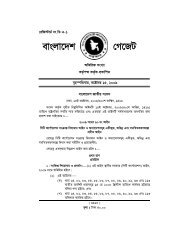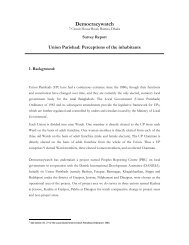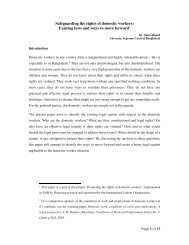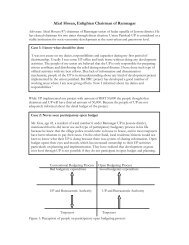Reproductive Decision Making Role among ... - Democracywatch
Reproductive Decision Making Role among ... - Democracywatch
Reproductive Decision Making Role among ... - Democracywatch
- No tags were found...
Create successful ePaper yourself
Turn your PDF publications into a flip-book with our unique Google optimized e-Paper software.
poor is even worse than that of the rural poor. Infant and maternal mortality rates are higherthan the national rates, and around one-third of the people in the slum communities arethought to be ill at any time. Also, more than 80 % of school-aged children in Dhaka slumsdo not attend school. All these factors are likely to adversely affect the contraceptivebehavior of those who live in the slums. These factors possibly also help to explain whyurbanization has had little effect on the declining fertility in Bangladesh.In 1994, the contraceptive prevalence rate (CPR) in slums was 40 %. This figure is muchlower than the national rate in urban areas of 54%, and lower than the national rate in ruralareas of 43% 17 . With this trend continuing, even if the family planning program achieves itstargeted objectives in the rural and urban formal sectors, the national CPR may not riseenough to attain the national goal of replacement level fertility (NRR=1) by 2005. Authors ofa recent national family planning strategic document suggested that, the government mustdevote special efforts as soon as possible to raise CPR in the slums in order to attain thenational goal within the stipulated period 18 . However, very little is currently known aboutreproductive behavior and family planning in the urban slums.<strong>Decision</strong> making capacity of a human being is one of those criteria which distinguish her/himfrom other species. Since it is related to intellectual ability to make the right choice and takeresponsibilities, recognizing the right of women to exercise decision making power alsorecognizes women as complete human being. But it is a historical fact that, women facemuch more challenges in accessing the decision making power just because of their sexualdifference.One of the most common health hazards of Bangladeshi women are the reproductive healthproblems which are indicated by the high maternal mortality rate (4.0 per 1000 live births).Fertility control like most other family decisions is not always an individual affair but involvesco-operation, discussion and joint decision making <strong>among</strong> couples. The nature ofrelationship existing <strong>among</strong> the couples affects the decision on family size. The status ofwomen in the family in particular and society in general is important in the decision authorityin the marital dyad. The way women interact with kins, neighbors, peers, and communityleader, health professionals’ etc. are significant extramarital influences in shaping thedecision style. Fertility decisions at a given time depend to a large extent on currentsituations within the family. Each birth may therefore be influenced by a different set ofmotivational, cultural and family conditions.A great number of barriers (for women) are rooted in social values, customs, beliefs andassumption about the nature of a woman and her capability. Males are generally referred toas the head of the home. These socially determined roles in the household have a significanteffect on decision-making that will determine ability to take advantage of opportunities thatwill then affect the educational, occupational, social and health-related status of members ofthe household along gender line. The social pressure to conform to the social elementsdetermining gender relationship is strong and deviation often carries a sanction, especiallyfor women.17 Barkat et al, 199518 Barkat et al, 1996
















